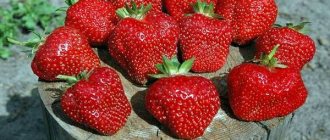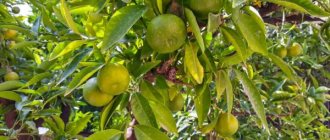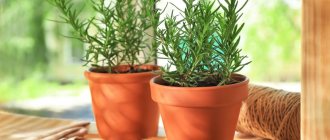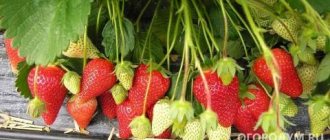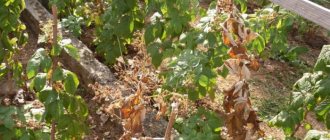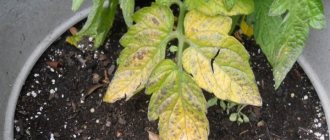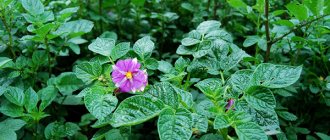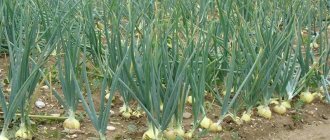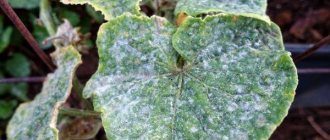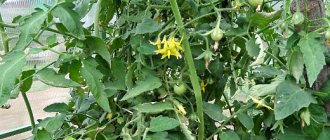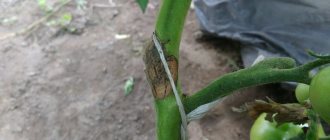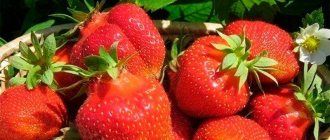The strawberry season is considered the richest and most generous among summer residents. The juicy vitamin berry is suitable for fresh consumption, making compotes, jams, and jelly. Strawberries are prepared frozen for the winter. The productivity of a strawberry bed increases with proper care and watering .
It is not clear why strawberry leaves turn yellow if all agrotechnical standards are met. The issue requires careful study in order to save the delicious berry bushes.
Inappropriate landing site
Inexperienced gardeners and vegetable gardeners often commit the wrong arrangement of beds. It is not recommended to plant strawberries in completely open areas, since direct rays of the sun will burn the leaves. If there is no other way out, then during solar activity the bushes need to be shaded with spunbond.
In addition, garden strawberries should be planted away from tulips and raspberries. Otherwise, the likelihood of the appearance of a common pest of these crops, the raspberry-strawberry weevil, increases.
Yellow spots on strawberry leaves also appear when this crop is grown in acidic soils, as well as in areas where plants from the Solanaceae and Asteraceae families were located last season.
Strawberry beds are best planted after cereals, radishes, garlic and parsley
At the same time, the bushes should not be placed too close. Otherwise, the roots do not receive the required amount of nutrients, the leaves create a shadow for each other, as a result of which weakened plants turn yellow, droop and dry out before the end of fruiting.
The distance between strawberry bushes should be at least 25 cm.
Strawberries dry out: what to do if the reasons have not been established?
If the reasons for the drying of strawberries are not clear, then it is worth trying to transplant the bushes to another place; perhaps there is an acute lack of nutrients in the soil or, conversely, there are too many of them due to excessive fertilizing. This can be confirmed not only by dry leaves, but also by changing color, twisted, wrinkled leaves, deformed peduncles and berries.
You can dig up a bush and inspect the roots, check if there is an anthill under it. It’s easy to get rid of ants by sprinkling the area with dry ash or watering it with a solution made of vinegar, vegetable oil and water. If there are no insects, but the roots have rotted, it means that the plant is flooded, and watering should be temporarily stopped or the area should be changed to a higher and drier one.
Another option is that the bushes are old, have grown too much, and need to be replanted. In this case, you need to separate the young shoots or root the tendrils to obtain new planting material and replace dry plants with it. The lifespan of strawberries is 3-4 years.
NEXT IS MORE INTERESTING...
Lack of moisture
Without proper watering, strawberry roots cannot absorb the nutrients they need. Plantings need to be regularly moistened, but it is important not to overwater the plants, since stagnant moisture in the soil provokes the rapid development of fungal diseases, in particular gray rot.
- Gray rot on garden strawberries: symptoms and control methods
And that berry is rotten! We analyze the most effective methods of combating gray rot.
- Gray mold - signs of the disease and ways to combat it
How to protect plants from gray rot?
It is best to water strawberries in the morning, since if you water in the evening, the soil may not have time to dry before the air temperature drops at night. Then the plant also runs the risk of getting sick.
The frequency of watering depends on soil type and weather. On average, they consume 10-12 liters of water per 1 sq.m.
To retain moisture in the soil, it is recommended to mulch strawberry plantings with straw.
Reasons for yellowing of garden strawberries
Strawberries, despite their unpretentiousness, are highly sensitive to adverse environmental factors. Any deviation can provoke a decrease in the plant’s immunity and, as a result, lead to infection with diseases and attack by pests. Even cultivation in compliance with all agricultural technologies sometimes ends in yellowing of the plant’s leaf blades, its stems, peduncles and fruits.
The list of situations that may affect the condition of garden strawberries and their appearance includes:
- Some fungal diseases.
- Pest activity.
- Lack of microelements and salts in the soil.
- Violations of agricultural technology.
Deficiency of plant nutrients
The most common cause of yellow leaves in strawberries is a lack of magnesium . This element is part of chlorophyll and takes part in plant photosynthesis. With magnesium deficiency, the leaves of garden strawberries acquire a brown, yellow or purple tint. In places where spots form, plant cells die.
To solve this problem, add magnesium sulfate to the soil (in the form of a solution - 15 g per 10 liters of water or dry granules - 20-25 g per 1 sq.m.). After a week, repeat the procedure.
- Magnesium sulfate: what fertilizer is needed for, instructions for use
How to properly use magnesium sulfate in the garden?
If there is a deficiency of nutrients, strawberries also need foliar feeding with magnesium sulfate
Also, strawberry leaves turn yellow due to lack of nitrogen . In advanced cases, they acquire not just a yellowish, but a rich lemon color. The bushes need to be fed with ammonium nitrate - preferably in the form of a solution (25-30 g of fertilizer per 10 liters of water).
- Ammonium nitrate - composition of fertilizer and its use in the country
We understand the intricacies of using one of the most popular fertilizers.
Why do strawberry leaves turn yellow and red in summer?
Sometimes when growing strawberries, gardeners encounter unpleasant phenomena. They discover that the leaves on strawberry bushes change color in the summer, namely, they turn red or yellow. What is this, a disease or the influence of pests?
Causes of yellowing foliage
If the leaf apparatus becomes lighter and yellowness becomes noticeable on it, but the veins remain green, this is chlorosis. Plants suffer, leaves turn white and fall off.
Such signs appear if the bushes are deficient in iron. Its deficiency and, as a consequence, chlorosis appears in poor calcareous (alkaline), carbonate or acidic soils. Due to the lack of iron in them, photosynthesis cannot occur or is sluggish.
The pale green color of the leaves indicates a disruption in the formation of chlorophyll, which causes the development of chlorosis. Becoming lifeless, the vegetative mass due to iron deficiency cannot ensure full fruiting.
Store-bought anti-chlorosis products
To remedy the situation, store-bought drugs are used:
- Iron chelate,
- Ferovit,
- Ferrilene,
- Micro-Fe,
- Antichlorosis and others.
They are intended to prevent iron deficiency.
Strawberries and wild strawberries are treated with them in the spring at the beginning of the growing season. Prepare a solution in accordance with the instructions; use a syringe to maintain the correct dosage. The proportions depend on the methods used in treatment.
Rules for using Ferovit
If you take the common iron-containing drug Ferovit, it is applied in several ways:
- The soil or soil mixture is spilled with the composition before planting. When used, dilute 1.5 ml of the drug in 5 liters of water.
- Vegetating bushes are fed at the root level at the rate of 1.5 ml of the substance for each liter of water. If the area is large, add 12-17 ml (or 1 tablespoon) of the product to a bucket of water.
- In the form of foliar feeding on the leaf.
Repeated root and leaf nutrition should be repeated 2-3 more times with an interval of 2 weeks.
Instructions for use Iron chelate
The drug Iron Chelate will cope with the problem if 1 tsp. dilute the powder in a 10-liter bucket.
To overcome iron deficiency, iron sulfate in the amount of 1 tbsp is also suitable. l., dissolved in the same volume of liquid.
The use of folk remedies
Instead of store-bought preparations, gardeners use self-prepared iron chelate. To obtain it, mix iron sulfate with citric (ascorbic) acid and boiled water.
In addition, you can provide bushes with iron using rusty metal objects. To do this, rusty nails, screws, pieces of reinforcement are stuck into a container or into open ground next to the root and watered to start the reaction.
If there is massive damage to chlorosis on a plot, it is fertilized with acidic mineral fertilizers, for example, superphosphate. Sowing green manure, removing infected leaves during growth and applying manure in the fall will help eliminate nutritional deficiencies.
Leaves turn red: disease or natural coloring
In summer, strawberry foliage turns red for several reasons. This may be a color change caused by dieback.
If it changes on the leaves along the edge of the bush after 2.5 -3 months from the beginning of the growing season, then this is a natural process. The young leaves that remain remain green.
Other causes of redness of strawberry leaves
In some cases, redness is caused by illness or lack of nutrients. If young leaf blades in the center turn red, this is a reaction of the bush to a high level of soil acidity.
The appearance of a purple tint indicates a lack of phosphorus. A plant whose leaves are all purple needs nitrogen. You can provide them with strawberries by adding urea. If the leaf edges are brown and dry, the crop should be fed with potassium sulfate.
Instead of the listed microelements, you can take complex fertilizers such as nitrophoska and azofoska. But the use of targeted fertilizer is more effective. It will not lead to “overfeeding” with those components that are sufficient in the soil.
Leaf color and fungal infections
Unlike signs associated with nutrient deficiencies, discoloration is often caused by white spot fungus.
Light spots with a dark outline are a symptom of a bacterial disease that requires treatment with fungicides. The harmful effects of the fungus are neutralized by drugs:
- Ridomil (shows effect no earlier than after 2 months),
- Acrobat,
- Propy Plus.
Dark brown angular marks that appear on strawberries are the result of brown spot infection. It can be overcome using sulfur-containing Topaz and Tilt.
Strawberries need to be processed before flowering or after harvesting. Due attention should be paid to prevention, which consists of cleaning the area from dry and affected leaves in autumn and spring. The fewer of them left, the greater the guarantee that the plants will be healthy.
Chlorosis
If strawberry leaves turn yellow in the spring, then there is a high probability that the plant has become ill with non-infectious chlorosis. In this case, the leaves become yellowish not completely, but between the veins.
This is what strawberries look like when they have non-infectious chlorosis
Why do garden strawberries get sick? The fact is that in spring the soil warms up more slowly than the air. Therefore, plant roots in cold conditions do not absorb moisture and nutrients well. In addition, the development of the disease is promoted by a high lime content in the soil. To help strawberries cope with chlorosis, you need to water the bushes with warm water and periodically spray them with a solution containing iron.
Read about other insidious diseases of this plant in the article Top 5 most dangerous strawberry diseases.
Pests
With the onset of warmth, insects wake up and damage the roots, stems and leaves of plants, and some of them (in particular, aphids) also carry an infection (for example, they infect crops with xanthosis). Thus, the cause of yellowing of leaves can be raspberry weevil, chafer beetle, pennies, aphids, and spider mites.
Fitoverm will help you cope with pests. Treat strawberry plantings with this preparation 3 times. Spray the first spray shortly before the buds appear, and the rest at intervals of 10-14 days.
Beneficial insects can help in pest control
You can get rid of pests living in the soil using potassium permanganate: 5 g of potassium permanganate is dissolved in 10 liters of warm water. The solution is poured onto the soil and thereby not only destroys insects, but also saturates the soil with useful elements.
Prevention
There are many reasons for the appearance of pale green leaves on strawberries. The plant will not change its color without reason. It is necessary to identify them and begin timely actions to eliminate them.
- How to use potassium humate for strawberries: using fertilizer for the garden. Composition, instructions for use and application methods (115 photos + video)
- Strawberry Roxana - 85 photos, description, reviews, planting and growing a productive variety
- Albion strawberries: detailed description of the variety, care rules and strawberry propagation options
Care for the beds where this crop grows must be carried out correctly. It is necessary to consider where and how to plant strawberries. Strawberries must be periodically fed with fertilizers and minerals.
Fight against harmful insects that can cause irreparable harm. Disinfect the soil in a timely manner and add ash, reducing its acidity.
Provide shade from the active sun and water the plants properly. Healthy plants will produce an excellent harvest and delight gardeners every year. The transplant must be carried out on time. The soil must first be fertilized and disinfected.
Preventive measures
Carrying out preventive measures will make the strawberry harvest richer. To do this, they focus on:
- choosing suitable strong seedlings;
- correct selection of site;
- burning of affected bushes;
- moderate fertilizing;
- spraying strawberries against harmful insects;
- avoiding cross-pollination of different varieties;
- replanting plants ideally every 2 years - as the strawberry bush ages, the number of diseases and parasites increases;
- It is undesirable to plant strawberries after tomatoes, peppers, eggplants, and potatoes for at least 3 years;
- thorough soil cultivation: a steep pitch is also suitable for eliminating fungal spores and larvae;
- weed removal;
- correct watering.
Improper care
Failure to comply with agricultural practices depletes the crop, and the once green strawberry bushes disturb the gardener with their unhealthy appearance.
Feeding
At each stage of the growing season: in early spring, during flowering, when it fades and enters the fruiting period, before winter, strawberry beds require a separate set of care measures.
In April in the south, May in Siberia, plants are fed with organic or mineral nitrogen: macronutrient deficiency is the main reason why the leaves of strawberry bushes turn yellow at the end of spring.
In June, at the peak of flowering, and later, when the ovaries appear, feed:
- phosphorus (without it the leaves turn red and then turn purple);
- potassium (with a deficiency, first a yellow rim along the contour, and then the golden rim becomes wider, thicker and gives way to drying of the edges);
- manganese (tips turn brown, dry, curl);
- boron (pale spots merge into yellow-red, speckled, the plate is deformed);
- iron (from the base, lemon yellowness spreads across the entire plate, except for the veins, then brown dry spots appear, the fabric frays, leaving holes);
If you leave strawberries without additional fertilizer before winter, in the spring the plant will signal starvation with yellowness.
Experienced gardeners know: it is not enough to properly fill the bed with young seedlings. Strawberries live in one place for up to 4 years - the berry crop is fed annually from spring to autumn with chemical and folk remedies. Summer residents, who have identified problems with fertilizing in time, adjust their care and state: the spots and pallor of the plants disappear when the strawberries receive nutrition.
Video about nutritional deficiency and nutrition:
If the gardener is confident that he is applying the necessary fertilizers on schedule, he should check whether there is overfeeding. The foliage instantly reacts to an excess of macro- and microelements by changing color. But it is more difficult to cope with the consequences of oversaturation - you will have to intensively water the beds to wash away the excess.
Watering
Consequences of improper watering:
- deficiency - yellowing, drying of foliage, falling flowers, baked berries (especially in the heat), attack by pests that prefer dry air, death of the plant;
- excess - root rotting, oxygen starvation, fungus, viral infections, invasion of insects - lovers of a damp environment.
The edges of the leaves dry out
Why do hosta leaves turn yellow and what to do?
The foliage dries out due to improper care or contamination of strawberries with harmful insects and diseases. Lack of attention and inaction lead to a decrease in strawberry yields. Infected plants dry out completely. The main thing is to find out why the edges of strawberry leaves dry out and what to do.
The edges of the leaves dry out
Among the reasons for strawberry leaves drying out are:
- lack of fertilizing;
- incorrect watering;
- pests.
The problem is caused by a lack of nitrogen fertilizer, but its excess also harms strawberries. Moderate watering is carried out in the evening. Chemicals will help you get rid of harmful insects.
Strawberry leaves will dry out if the plantings are dense or the bushes have a root system damaged by parasites. The crop rotation may be disrupted: strawberries have occupied the same plot for more than 5 years.
The bushes may have a root system damaged by parasites
Thickened plantings are thinned out. After harvesting, it is recommended to mow the strawberry plantation and burn the leaves. Next it is treated with colloidal sulfur. Afterwards, the beds are loosened and fertilizer is applied.
No. 3 Incorrect feeding
Deformation of cyclamen leaves due to improper feeding
The existing opinion that indoor plants can be fed with the same substances or compounds as garden (or vegetable) crops is only partly true.
Plants located outdoors have much more opportunities to receive nutrition from the environment than indoor plants, if only because the size of their root system is practically unlimited. And most importantly, this root system has at its disposal a much larger area of land, containing almost all the necessary microelements at different levels.
An example of leaf curling in petunia seedlings
Therefore, for them, only the presence of basic substances that go into the direct formation of the vegetative part and fruits (nitrogen, potassium, magnesium) is critical. And almost all the substances that regulate their vital functions are present in relative abundance. Indoor plants with a limited volume of soil are deprived of this opportunity.
Most often, the leaves of indoor flowers curl due to a lack of substances such as molybdenum, manganese, sulfur, boron and iron. The problem can be solved very simply - use specialized fertilizers for indoor plants, containing the entire necessary range of nutrients.
Another problem associated with fertilizing that leads to leaf curling is an overdose of potassium and nitrogen in indoor plants. These substances have the ability to accumulate in plant tissues and react with various compounds, thereby disrupting metabolism and the processes of formation of new cells. Therefore, gardeners should always follow the norms for applying certain products.
Complex fertilizer for flowers
It is recommended that when using specialized complex fertilizers for ornamental crops for the first time, they are applied in a concentration half the recommended amount in order to see how the plant will respond to fertilizing. If everything goes well, the norm is applied in full.
Why do zucchini ovaries rot?
